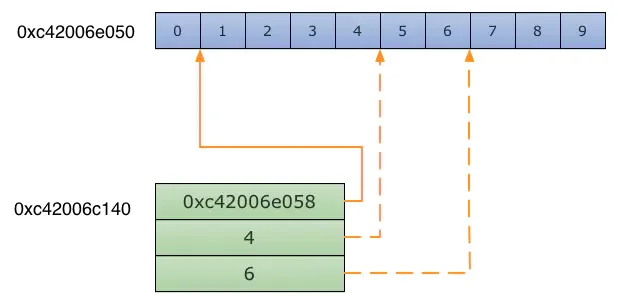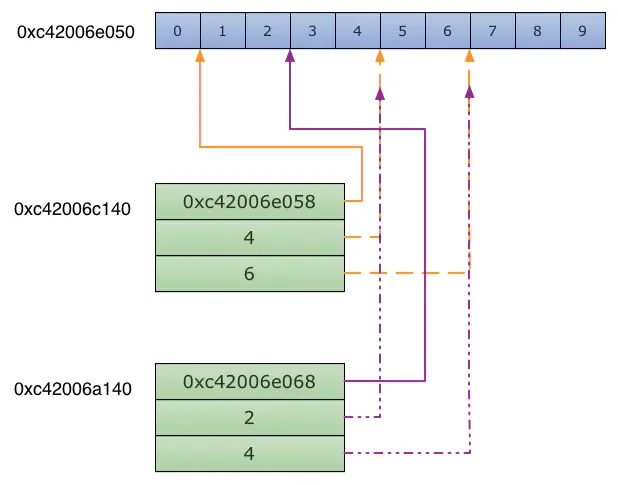首先我们来看段代码的输出
s := make([][]int, 4)
for i := 0; i < 4; i++ {
s[i] = make([]int, 4)
s[i][0] = 1
}
s0 := s[0]
s0 = append(s0, 5)
fmt.Println(s)
输出的结果是
[[1 0 0 0] [1 0 0 0] [1 0 0 0] [1 0 0 0]]
append的值5并没有输出,那么究竟是s0并不等价于s[0],还是有其他原因呢?
首先,肯定的是在Go中,所有的拷贝都是值拷贝,不存在引用拷贝;
其次,slice由一个指针,两个整型(分别是size和cap)来实现,既然s0包含的指针和s[0]包含的指针相同,为什么append操作并没有达到预期效果呢?
带着这些疑问,我们来看看slice的底层实现。
slice的结构
type slice struct {
array unsafe.Pointer
len int
cap int
}
array指向一个数组元素的地址,这个数组可能在makeslice时创建,也可能之前就存在,而slice被"attach"上去,例如 s := a[0:5];
//代码比较简单
func makeslice(et *_type, len, cap int) slice {
maxElements := maxSliceCap(et.size)
if len < 0 || uintptr(len) > maxElements {
panic(errorString("makeslice: len out of range"))
}
if cap < len || uintptr(cap) > maxElements {
panic(errorString("makeslice: cap out of range"))
}
//分配数组空间
p := mallocgc(et.size*uintptr(cap), et, true)
return slice{p, len, cap}
}
e.g.
s := make([]int, 1, 3)
fmt.Printf("%p, %v, len:%d, cap:%d", unsafe.Pointer(&s[0]), s, len(s), cap(s))
输出:
0xc42007c0a0, [0], len:1, cap:3
对于直接"attach"到数组的情形,类似下面这样
a := [10]int{0,1,2,3,4,5,6,7,8,9}
fmt.Printf("%p, %v \n", &a, a)
s1 := a[1:5:7]
fmt.Printf("%p, %v, len:%d, cap:%d, self:%p \n", unsafe.Pointer(&s1[0]), s1, len(s1), cap(s1), unsafe.Pointer(&s1) )
输出:
0xc42006e050, [0 1 2 3 4 5 6 7 8 9]
0xc42006e058, [1 2 3 4], len:4, cap:6, self:0xc42006c140
根据两个指针的关系,可以看出,slice直接指向了数组中的元素

slice attach1
同理,slice2还可以通过另一个slice1构造,但其属性依赖slice1,并不是slice1底层的数组
s2 := s1[2:]
fmt.Printf("%p, %v, len:%d, cap:%d, self:%p \n", unsafe.Pointer(&s2[0]), s2, len(s2), cap(s2), unsafe.Pointer(&s2) )
输出
0xc42006e068, [3 4], len:2, cap:4, self:0xc42006a140

slice attach2
修改slice中元素的值,实际上修改的是底层数组元素的值
s2[0] = 100
fmt.Println(a, s1, s2)
输出
[0 1 2 100 4 5 6 7 8 9] [1 2 100 4] [100 4]
扩张
当我们对slice进行append操作时,若len + 追加元素个数 <= cap时,不会发生内存扩张;否则,新的内存被申请,同时旧的数据被拷贝至新内存的前部;
先上代码
func growslice(et *_type, old slice, cap int) slice {
......
if et.size == 0 {
if cap < old.cap {
panic(errorString("growslice: cap out of range"))
}
return slice{unsafe.Pointer(&zerobase), old.len, cap}
}
// 计算新的cap,针对不同情况分别处理
newcap := old.cap
doublecap := newcap + newcap
if cap > doublecap {
newcap = cap
} else {
if old.len < 1024 {
//2倍
newcap = doublecap
} else {
//每次尝试扩1/4
for newcap < cap {
newcap += newcap / 4
}
}
}
var lenmem, newlenmem, capmem uintptr
const ptrSize = unsafe.Sizeof((*byte)(nil))
switch et.size {
case 1:
lenmem = uintptr(old.len)
newlenmem = uintptr(cap)
capmem = roundupsize(uintptr(newcap))
newcap = int(capmem)
case ptrSize:
lenmem = uintptr(old.len) * ptrSize
newlenmem = uintptr(cap) * ptrSize
capmem = roundupsize(uintptr(newcap) * ptrSize)
newcap = int(capmem / ptrSize)
default:
lenmem = uintptr(old.len) * et.size
newlenmem = uintptr(cap) * et.size
capmem = roundupsize(uintptr(newcap) * et.size)
newcap = int(capmem / et.size)
}
......
var p unsafe.Pointer
if et.kind&kindNoPointers != 0 {
//这里有个优化细节,先不zero,因为前部会发生覆盖
p = mallocgc(capmem, nil, false)
memmove(p, old.array, lenmem)
//只对后部zero
memclrNoHeapPointers(add(p, newlenmem), capmem-newlenmem)
} else {
p = mallocgc(capmem, et, true)
if !writeBarrier.enabled {
memmove(p, old.array, lenmem)
} else {
for i := uintptr(0); i < lenmem; i += et.size {
typedmemmove(et, add(p, i), add(old.array, i))
}
}
}
return slice{p, old.len, newcap}
}
当不需要扩容时,append会修改底层数组的值
s2 = append(s2, 1000)
fmt.Printf("%p, %v \n", unsafe.Pointer(&s2[0]), s2)
fmt.Println(a, s1, s2)
fmt.Printf("len(s1)=%d, cap(s1)=%d, len(s2)=%d, cap(s2)=%d", len(s1), cap(s1), len(s2), cap(s2))
输出
[0 1 2 100 4 1000 6 7 8 9] [1 2 100 4] [100 4 1000]
len(s1)=4, cap(s1)=6, len(s2)=3, cap(s2)=4
注意,对s2的append,仅改变了s2的len,并没有改变s1的len
当append过多时,slice底层数组会发生变化
s2 = append(s2, 1000, 1001, 1002)
fmt.Printf("%p, %v \n", unsafe.Pointer(&s2[0]), s2)
fmt.Println(a, s1, s2)
fmt.Printf("len(s1)=%d, cap(s1)=%d, len(s2)=%d, cap(s2)=%d", len(s1), cap(s1), len(s2), cap(s2))
输出
0xc420014280, [100 4 1000 1001 1002]
[0 1 2 100 4 5 6 7 8 9] [1 2 100 4] [100 4 1000 1001 1002]
len(s1)=4, cap(s1)=6, len(s2)=5, cap(s2)=8
原数组a,切片s1的属性未受影响;但s2底层的数组已发生变化,cap也是之前的2倍。
总结
1、多个slice指向相同的底层数组时,修改其中一个slice,可能会影响其他slice的值;
2、slice作为参数传递时,比数组更为高效,因为slice的结构比较小;
3、slice在扩张时,可能会发生底层数组的变更及内存拷贝;
4、因为slice引用了数组,这可能导致数组空间不会被gc,当数组空间很大,而slice引用内容很少时尤为严重;
